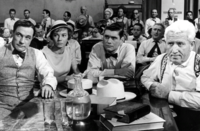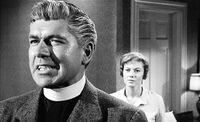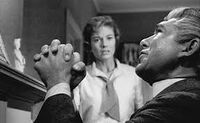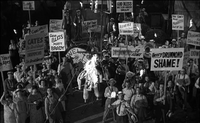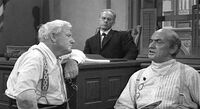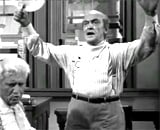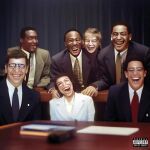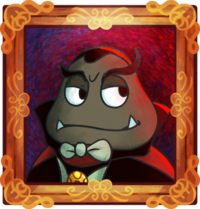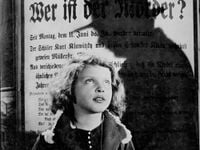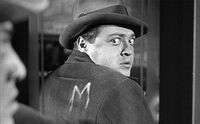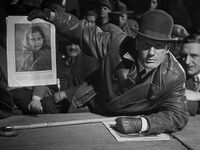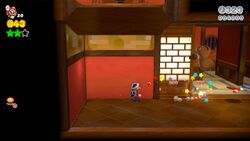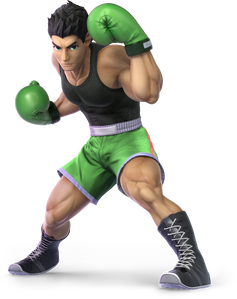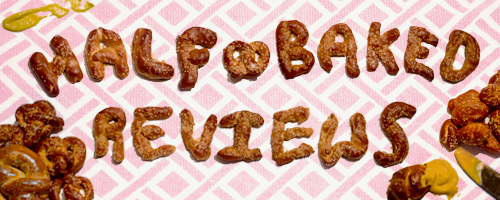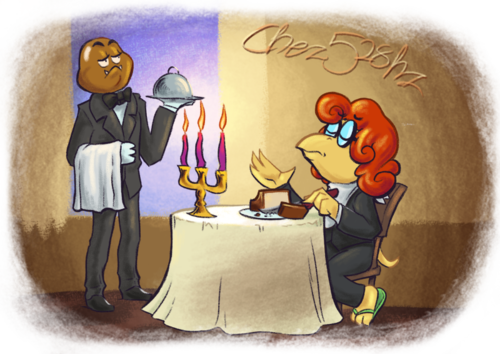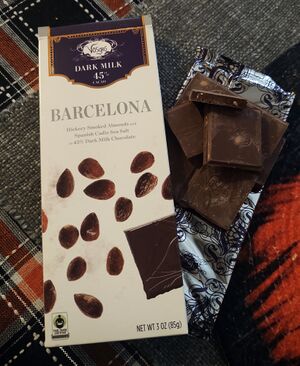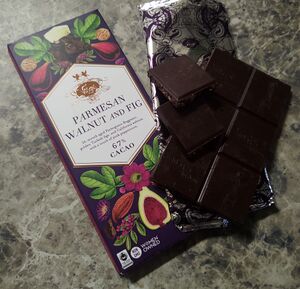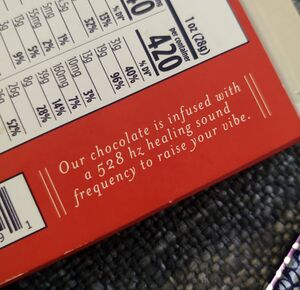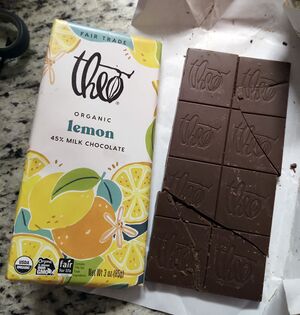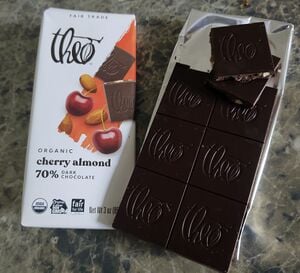The 'Shroom:Issue 191/Critic Corner
Director's Notes
Welcome to February, the most second month of the year! The month where you go "oh god it's already February?!" and by the time you exclaim that it's basically already March. We also bring you this month, courtesy of Hooded Pitohui (talk) a movie review, submitted as a one-time review through our no-signup process! Everyone should watch movies and review them!
Thank you for voting Half-Baked Reviews as January's Critic Corner Section of the Month!! Be sure to give your love to all of our sections here, and give a shout out to our writers whether in chat or in their forum threads dedicated to their sections. Be sure to vote vote vote!
And now for my regular announcements: We've decided to implement in Critic Corner something similar to News Flush over in Fake News, where no formal sign-up application process is required for one-time or limited sections. From now on if you just want to send in a single review for something you just read, watched played, tried, whatever, you just have to send me your review privately either to me directly in chat, or in a message to me on the forum at least one week before each 'Shroom is to be released! There's no commitment or obligation to provide a full monthly section (although you absolutely can shift it into one if you so choose), just send us your thoughts on a thing and we'll feature it here! If you have any questions or curiosities about this, please feel free to ask!
As always, if you would like to help Critic Corner, we always have openings for more writers! You are free to write for sections such as Character Review and Movie Review, or really anything you'd like to do! There's no pressure to have a huge section; they can be shorter and concise! The application process is very simple, starting with reading the Sign Up page, and sending your application to Meta Knight on the forum. Any idea you have is welcome, and if you have any questions or need help signing up, please feel free to reach out to myself or other 'Shroom peeps!
Section of the Month
| CRITIC CORNER SECTION OF THE MONTH | ||||
|---|---|---|---|---|
| Place | Section | Votes | % | Writer |
| 1st | Anton's Half-Baked Reviews | 8 | 42.11% | Hypnotoad (talk) |
| 2nd | A Report on the Effectiveness of Power-Ups | 3 | 15.79% | Mustard Machine (talk) |
| 2nd | All-Time Smash Merit Ranking | 3 | 15.79% | SonicMario (talk) |
Movie Review
Written by: Hooded Pitohui (talk)
| Inherit the Wind | |
|---|---|
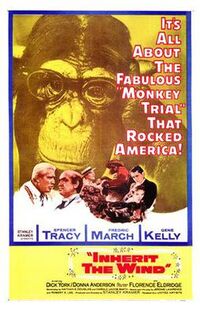
| |
| Director | Stanley Kramer |
| Starring | Spencer Tracy, Fredric March, Gene Kelly, Dick York, Donna Anderson, Harry Morgan |
| Runtime | 128 minutes |
| Release date | 21 July 1960 |
- “He that troubleth his own house shall inherit the wind”
- —Proverbs 11:29
From the above passage, the 1960 drama Inherit the Wind, like the 1955 play from which it was adapted, takes not only its title, but its central and most powerful idea. This is a film that begins with a narrow, focused thesis and lets its ideas flow out from that thesis and lets its characters reflect it. I wouldn't call Inherit the Wind an outstanding film deserving of a stream of accolades, but it is a great film, and one that excels at building from its thesis. Through three of its characters and a handful of key scenes, it demonstrates exactly how a film can go about crafting an argument and presenting it to an audience, and I think it's worth further exploring just how it does it.
Before we dive deeper in, however, let's back up and begin with an overview of the film itself. A fictionalized version of the infamous 1925 Scopes Monkey Trial, Inherit the Wind is the story of the small southern town of "Heavenly" Hillsboro, a town which, after arresting local teacher Bertram Cates (played by Dick York) for violating a state law forbidding the teaching of evolution by natural selection in public schools, finds itself in the middle of a nationwide media storm. With all eyes on the deeply religious town and the coming trial, celebrated orator and three-time presidential candidate Matthew Harrison Brady (played by Fredric March, and the film's stand-in for the William Jennings Bryan) offers to come into town to assist the local prosecutor in prosecuting the case. Meanwhile, after reaching out to sympathetic newspapers for help, Cates gets a visit from journalist E. K. Hornbeck (played by Gene Kelly) of the Baltimore Herald, who arranges for famed lawyer Henry Drummond (played by Spencer Tracy, and the film's stand-in for Clarence Darrow) to represent Cates as a defense attorney. Thus, with everyone in town, including the respected Reverend Jeremiah Brown and his daughter (and Bertram Cates' bride-to-be) Rachel, watching, and the whole country keeping up via radio and newspaper, the stage is set for a spectacularly dramatic trial.
Now, in broad strokes, that's more or less all you need to know about the film to follow along, but, before continuing, it's worth discussing the proverb that gives the film its name. The first half of Proverbs 11:29, the quotation adapted into a title is more or less a warning against causing division and discord within one's family, though one can expand "family" metaphorically to mean any community one likes, be it a nation, a religious order, business, volunteer group, etc. No matter how much one might benefit from playing on and widening divisions and castigating members of their own metaphorical family in the short-term, in the long-term, they're bound to end up left with nothing but a shattered, tarnished legacy and the painful awareness that there's nobody left who cares about them. At best, everybody abandons them, and at worst, the one cultivating a household of sharks, ready to swarm when they sense the smallest drop of blood in the water, is bound to find that the sharks turn on them to tear them apart and chew them up the moment they get a scrape.
One might accept that proposition, one might think it overly broad and difficult to generalize to all situations, and others might feel it wrong entirely. I'm not interested in arguing for or against it broadly, but I am interested in arguing that this movie takes a firm stance on its accuracy and presents a powerful case for its position, and, crucially, that the movie is better for it.
Establishing its thesis possibly before the audience even realizes that it's doing so, the film opens immediately with a look at a community divided, with the civic leaders of Hillsboro, ranging from the mayor to the town's bank's owner, reading reports on Cates' arrest and the anticipated trial and debating on what they ought to do about the whole affair. Some in the room note that the town is attracting a great deal of negative publicity and that universities across the country may grow reluctant to accept students from Hillsboro and the state, putting its residents at a disadvantage, while others argue it is imperative Hillsboro stand up for its beliefs rather than relenting to the city slickers trying to impose their way of life on everyone else. At this stage, the cracks in the community are small, and they are quickly patched up when a message arrives stating that Matthew Brady has offered to take the case, but they are present right from the outset of the film, making clear that, by troubling an upstanding young member of their community for questioning what he had been taught and for educating the town's youth, the residents of Hillsboro are putting the fabric of their community and their community's reputation at risk. It does a terrific job of setting the stage for the rest of the film, not only quickly establishing that a trial capturing the attention of the nation is coming up and what the trial will center on, but also quietly introducing the idea that the insistence on prosecuting Cates for daring to question the religious beliefs of the town is leading Hillsboro onto a path of eventual ruin.
Not long after this, the film provides its first extended look at the duo it uses to illustrate its core message on a personal level. Reverend Brown and daughter Rachel are the literal household torn asunder during the course of the film. Our first good look at the father-daughter duo together is a tense confrontation that comes when the pastor finds Rachel coming home for supper late because she had stopped to see Cates in his holding cell. The reverend makes it expressly clear that he disapproves of Rachel fraternizing with Cates and is totally opposed to her remaining committed to marry him. Rachel, in turn, begs him not to stand in her way and begs that he sees the good in Cates, that he sees the man she knows him to be. In a dramatic display, the Reverend channels all of the energy to be expected from a fire-and-brimstone Southern pastor and drops down on his knees in front of the photo of Rachel's late mother on the mantle. With tears streaming down his face and trembling hands, he pleads with the Lord for guidance and asks forgiveness for failing to keep Rachel on a righteous path, keeping the performance up despite Rachel's discomfort and her begging that he stop. The display only ends when a frustrated Rachel reaches her limit and storms off, leaving her father to continue his blubbering and pleading until he composes himself offscreen.
While this first extended look at the Brown family introduces us to their conflict and the growing rift between them, the climax of their joint story comes a few scenes later, at the "prayer meeting" held the night after jury selection finishes. Showing how strongly he commands the support of the on-edge community in Hillsboro, who have succumbed to a mob mentality and are parading through the streets at night proclaiming their intent to hang Cates and Drummond from "a sour apple tree" while burning them in effigy, Reverend Brown gives a true fire-and-brimstone sermon that comes to a climax when he declares that anyone who would speak even a word against the words of the Lord is a damned sinner bound to burn eternally in Hell.
The whole scene is great on its own. The performance is passionate, the framing, with angled shots of enraged crowds responding in unison, calls to mind extremist rallies. Standalone, it's probably the best scene in the film from a technical perspective, if a bit cliché and lacking in the excellent banter the rest of the film has, but it doesn't stand alone, because, as the Reverend makes his declaration, Rachel runs through the crowd to her father, once again at her breaking point and begging that he take those words back, hoping beyond hope that her love isn't actually eternally damned. In response, Reverend Brown more or less tells her without losing any righteous fury that, she, too, is bound to eternal damnation for defending the sinner Cates. It's a pretty heavy thing to tell your own daughter, and it turns out that someone else can see that things have gone too far, as Matthew Brady, heretofore seemingly a man with few morals who was happy to bombastically and pompously defend the people of Heavenly Hillsboro and their beliefs, intervenes. He steps between the father and daughter and defends Rachel, calming and dispersing the crowd and even tempering the Reverend's righteous anger and fervor by quoting Proverbs 11:29 (providing the film's title drop in the process). Despite Brady's intervention, what had started as a crack in the Brown household becomes a full rupture in this moment, with Rachel going to spend the night with Brady and his wife, Sara, both no longer welcome to and no longer willing to return home. While her support for Cates at this stage still wavers, the rift between Rachel and her father becomes irreparable at this point, and, while he still has the community on his side for now, Reverend Brown has nothing left in his actual household save for the wind.
The story of the Brown family adds a key element to the film's central message, giving it a personal dimension that really adds to the emotional impact. It can be difficult to translate the abstract idea of a community fracturing and turning on itself to a personal experience, but most anyone can immediately place themselves in the shoes of Reverend Brown and Rachel, thinking back on a parent-child conflict, sibling-sibling conflict, or really any familial conflict. Most anyone is going to be able to understand the shouting and the tears involved and how isolating and exhausting these conflicts are, and it's certainly not hard to feel the sense of betrayal, confusion, and anger Rachel feels as her father manipulates her with his overly dramatic displays and humiliates her publicly. All it takes is an estranged family member in a viewer's own life for a viewer to realize how deep of a rift - likely an irreparable one - this conflict leaves in the Brown family, how disorienting it is for Rachel and how alone Reverend Brown is bound to be in his four empty walls, with his daughter removing herself from his life. It may be to Rachel's betterment to leave her father behind, but even she has to go through a period of pain and isolation, and the reverend himself, well, he's put himself firmly on a path to ruin. Through the lens of this single family of two, the film articulates its central thesis in the clearest of terms, practically grabbing its audience by the shoulders and going "look at what happens!". It's not the most subtle of deliveries, but it's highly effective, an unmistakable, unforgettable warning of what awaits those who trouble their own homes, nothing but pain and the fracturing of the home.
Though that might be the climax of the Browns' story, it's not the climax of the film, and, though it has already laid bare its message, the film presses ahead with making its case for its central thesis through Matthew Brady. Throughout the whole film to this point, we've seen Matthew Brady as a man reveling in the attention the trial is bringing him, never staying quiet when he can have the spotlight. Even through meals, he just has no inclination to pipe down, something Drummond and Sara wryly observe when they sit down for an actual conversation over a meal while Brady prattles on in the background. Outside of two moments (a rocking chair conversation with Drummond where the two men discuss their old friendship and the prayer meeting scene where Brady intervenes on Rachel's behalf), Brady remains utterly caught up in his own hype from the moment the town welcomes him with a parade. It makes it quite surprising, actually, that he finally puts the brakes on the proceedings to intervene during the prayer meeting and that he and Sara comfort Rachel and offer to bring her back to their lodgings. For a brief moment, it seems that we're seeing a different side of Brady, that his humanity and his compassion is causing him to finally reconsider how far this form of mob justice has come.
This illusion is quickly shattered the following day in court when Brady calls Rachel to the witness stand. Using information that Rachel shared with him in her most vulnerable moment, while with Brady and his wife in the immediate aftermath of her public confrontation with her father, Brady extracts information from Rachel that is absolutely damning to Cates' defense. Putting Rachel through the wringer, reducing her to tears once again, Brady forces Rachel to tell the court and the people of Hillsboro that Cates had come to outright reject the church as it existed in Hillsboro, leaving it entirely and disputing the teachings of Reverend Brown. Whatever standing Cates might have left in town is destroyed, and Rachel's own reputation comes out thoroughly ruined. All for the purposes of advancing his case, winning the trial and earning more praise and admiration, Brady throws two people under the bus, forces a woman into a public breakdown, and betrays the confidence of a woman who was at her lowest who thought she could find help from him. It's a vile act, but, while the audience watching on the other side of the screen may find it objectionable, the town of Hillsboro approves. They continue their marching and calling for Drummond and Cates to hang that night. They fully turn on Rachel. They continue to staunchly support Brady. Brady demonstrates that, knowing he's been feeding this town of sharks and encouraging their behavior all this time, he's more than happy to cut open anyone he needs to in order to put more blood in the water so the town will keep looking to him as their hero.
Unfortunately for Brady, but fortunately for common decency, his gains from this act prove short-lived. After a tense confrontation between Rachel and Sara late in the night after the act, Sara clues Brady in that he may have gone too far this time, abandoning the morals that ought to have grounded him in favor of pursuing fame. More pressingly for Brady, the next day in court, Drummond calls Brady himself to the witness stand, citing his relevance to the case as an expert on the Bible. This gives Drummond the opportunity to question Brady on his beliefs, specifically his beliefs in a literal interpretation of the Bible and on apparent contradictions in the book. Through his line of questioning, Drummond corners Brady and forces him to admit that the words of the Bible might not be entirely literal. That admission alone is quite the transgression in Heavenly Hillsboro, and, even more damningly for Brady, it opens up the possibility that Brady doubts parts of the scriptures. The town, so trained to swarm, to chew up anyone who expresses any doubt in the literal readings of the book espoused by their reverend, swiftly turns on Brady. The sheen that had made him an unassailable shining messiah dulls; his golden aura rusts. No longer a leader, but just a man, and one capable of mistakes, Brady becomes an object of the town's scrutiny, no longer better to Hillsboro than Cates or Rachel. Brady, it turns out, can also bleed, and when there's blood in the water, the town swarms.
By the trial's conclusion, Brady is a broken man. He actually wins the trial, but he's hardly concerned with the result, all too aware that the town's residents - and possibly swathes of the nation - have turned against him. Desperate to reestablish his credentials as a man of God, as an upstanding individual no different than anyone else in Hillsboro, he frantically tries to fit in a concluding speech after the trial, growing increasingly distraught as he realizes that nobody, save for his wife and those behind the defense's bench, is listening to him. As he had for the entire movie, Brady talks, but this time, nobody pays him any mind. Increasingly unhinged, Brady suddenly collapses in the middle of his speech, with the following scenes making clear he had died, his cause of death given as a "busted belly," though presumably attributable to his breakdown. As the film reaches its end, it's made abundantly clear that there are no mourners, nobody concerned with Brady's death - aside from Sara and Drummond, that is. The man who had literally been welcomed into town with a parade, for troubling his fellow man, ultimately dies in disgrace, ostracized in Hillsboro and beyond and with only two souls to weep for him.
His actions may be despicable, but, as a character, Matthew Brady is great, and, frankly, I'd call him the main character of the film. Cates may be on trial, and we may follow Drummond, but it's Brady who has an arc that sums up the film's central message. It's Brady who becomes a cautionary tale for the audience. One might think themself more clever than the people of Hillsboro who have only been presented with one worldview, more moral and compassionate than Reverend Brown and his ulterior motive for wanting to keep the community listening to him, and one might be right! Yet Matthew Brady, too, is an outsider and a very well-educated man. He's not only broadly educated; he's aware of the very danger he embraces! He, after all, is the one who quotes Proverbs 11:29 to stop Reverend Brown. He fully knows the risks that his actions entail, but the praise, the power it gives him over a community, it blinds him, and in his prideful quest for more, he abandons his morals. He abandons the principles of compassion, of forgiveness and decency to his fellow man, and, for all the pain and division he sows, he ultimately inherits the wind. He's the embodiment of the film's message, the fulfillment of its thesis that any man, no matter how intelligent and popular, stands to lose everything by choosing to trouble their metaphorical household. He's the perfect cautionary tale, and it's through his story that the film makes its argument and hands it off to the audience to ponder.
There's so much more I could say about this movie. I could write a couple paragraphs on the banter alone. The banter is high-quality, with the dialogue fast-paced and witty but often pointed. The film mixes plenty of chances to chuckle at Brady and Drummond arguing over the use of the title of "Colonel" in court or trading remarks on Drummond's clothing with chances to reflect on its characters when, say, Hornbeck's actual commitment to his professed mission to "comfort the afflicted and afflict the comfortable" or an exasperated Drummond questions whether Brady "thinks about the things [he] does think about". Conversely, I could criticize the film for some of its meandering parade scenes and how it pads its runtime. That said, though, I've already explained where this movie shines, which is what I hoped to focus on in this review.
Inherit the Wind is made great not by its cast or its banter, though they do help, not by its cinematography or score, not even by its story. The film, instead, is elevated by its clear vision of its central thesis and its commitment to making an argument to the audience. From the outset, the film knows and lays out what it wants viewers to walk away with in their minds. Through the Browns, the film makes its argument through the lens of a personal conflict, relatable to most, so as to make the audience understand the consequences of troubling their own households. Having reached out to the audience emotionally, the film hammers its warning in through Matthew Brady, a man who begins on the top of the world and who loses it all, an educated man that, without due caution, any member of the audience could follow to a lonely grave. It may be a simple film with a simple story, but it's a great example of how to build a film around a central thesis.
'Shroom FM
Written by: MrConcreteDonkey (talk)
Welcome to 'Shroom FM - here are some albums from the far off, distant month of "JANUARY 2023":
NICOLE DOLLANGANGER - MARRIED IN MOUNT AIRY
Can definitely commend this for the atmosphere it creates; the slow, melancholic guitars complement the haunting sweetness of Dollanganger's vocals well. The narratives she creates in the lyrics are well-established. I didn't massively click with the first track, there's a point about a minute in where there's (what I believe to be) a vocal effect layered over Dollanganger's backing vocals to make them sound like a violin (it might be an actual violin? Not sure). It's clearly trying to sound ghostly and spooky but in practice it's just a bit annoying - and the rest of the song just felt very drawn out. The next few songs were pretty good - ethereal harmonies, engaging instrumentation, nice and dynamic - but then from "Bad Man" onwards my interest completely dropped off, unfortunately. It definitely felt like the album had run out of ideas, which is a shame because there's a lot of cool elements to this.LIL YACHTY - LET'S START HERE
A strange record not least due to the uncanny AI cover art, Let's Start Here garnered a lot of attention and bewilderment on the day it was released. And it's definitely interesting to look back on it with hindsight now that the hype has died down a bit, because - once you get past the fact that you're listening to a psychedelic rock album by the guy who made Lil Boat - it's not anything too special. Musically it's competent, catchy and quite imaginative at points, but on the whole Yachty rarely does anything new or interesting with the genre. The most unique thing about Yachty's approach is his vocals which are still heavily autotuned. Unfortunately, it's something I find annoying on his trap output and it's something I find just as annoying here - the weird floatiness and high pitch just makes it sound like he's fascinated by everything he's saying. That said, there are a few moments where the autotune does correlate quite well with the spacey, ethereal instrumentals - the verses of 'sAy sOMETHINg', for instance - but these are few and far between. Ultimately this meant the moments I enjoyed most were largely those where the autotune was less grating (it's insane how much better Yachty's voice sounds on the less autotune-heavy parts, such as 'drive ME crazy!') or those which featured the other vocalists more. This also means lyrically most of this passed me by. But still, it's cool to see Yachty doing something completely different, and it's very clear he has a lot of passion for this sort of thing. But it's not much better than alright.PARANNOUL - AFTER THE MAGIC
This is Parannoul's third album, following 2021's To See the Next Part of the Dream, which somebody reading this may remember I reviewed back when it came out - though he has done quite a few things since, including 2022's Rough and Beautiful Place under the monicker Mydreamfever (I reviewed this one too!! Look!!) and a few EPs and collab projects. Compared to his last album, After the Magic spends a lot more time building towards its louder moments rather than consistently being loud for its entire runtime. Because of this, a lot of the tracks end up following quite a similar pattern, starting quiet, clean and acoustic and then moving towards the clattering drums and huge guitars for the ending - so, a few tracks into the album, the louder, bigger moments unfortunately start to lose their edge a little. There's plenty of fantastic and innovative moments here, though - "Insomnia" has a steady breakbeat running through it, which works exceptionally well when the percussion builds up around it at the end of the track; "Parade" is very warm and has a really vibrant, wide range of instrumentation. In general, though, the album did leave me a bit underwhelmed - quite a few of the tracks here, while good, didn't do a huge amount to stand out. From "Imagination" onwards (ironically), it does feel like the album has basically already played its full hand and doesn't really bring anything new to the table. Overall, "After the Magic" is quite an apt title for this album, as it doesn't fully capture the magic of his last album, but it's still a very good project and the highlights here are breathtaking. That's the sentence I was working towards. If this review was a song on this album then that would be the loud bit.RYUICHI SAKAMOTO - 12 ⭐
Ryuichi Sakamoto has been suffering with stage 4 cancer for the past few years, and the compositions on this album are largely sparse, ambient piano and synth tracks he's recorded since October 2021. They're (almost) all ordered and titled by the date they were recorded. While Sakamoto's piano and synth work here is sublime, the background noise in the tracks is just as important - from the third track onwards, you can hear Sakamoto breathing as he's playing the piano, and the fourth track is backed by rushing winds and birds. This gives the album such a huge amount of depth, and makes the whole recording process very intimate. It's obvious to mention but it does feel a lot like a diary. The only track with a title other than the date is '20220302 - sarabande', and from here the album moves towards shorter, less ambient piano tracks. It's still just as mellow and bittersweet as before, and none of the closeness or emotion feels lost. Overall, 12 is, while quite subdued, still a deeply moving and very personal project.Further listening
Van Shoeul's House of Ghouls
By: Mustard Machine (talk)
| M | |
|---|---|
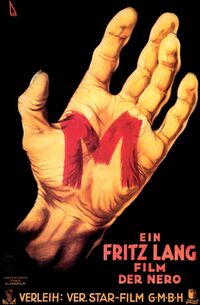
| |
| Genres | Murder Mystery, Suspense |
| Release date | 1931 |
| Starring | Peter Lorre, Otto Wernicke , Gustaf Gründgens |
| Directed By | Fritz Lang |
| Runtime | 86 minutes |
| Streaming | YouTube, HBO Max, Plex |
Good evening, dear readers, and welcome to another haunting Van Shoeul's House of Ghouls. I'm your director of this play of madness, Vincent Van Shoeul. For this month's performance selected for your enjoyment, we've dug deep into the historical vault. For this month, we have selected one of film's earliest thrillers and the first foreign film to appear on the program. We'll look together at the 1931 murder-mystery M, a haunting tale of a manhunt to track down a dangerous child murderer before he strikes again. Before we begin, I feel it is my duty to warn those prone to shock to look away, to move onto the next review before it's to late. But for those of you that remain, I promise you tonight's tale will be a thriller.
For tonight's featured performers, we have: Ellen Widmann as Frau Beckmann, the grieving mother of the killer's last victim; Otto Wernicke as Inspector Karl Lohmann, the head inspector for the Berlin police, determined to track down the killer; and Gustaf Gründgens as Der Schränker (The Safecracker), the leader of Berlin's underworld, determined to eliminate the killer his own way. Finally, we have legendary actor Peter Lorre in his first starring role as Hans Becker, a child-murdering serial killer tormented by voices inside his head.
The film begins with children walking home from school. A little girl plays with a ball before coming to a sign that warns of a murderer, offering a 10,000 marks reward. A man, only seen only in silhouette, then approaches the girl.
In between this, we're shown scenes of a woman doing chores as she waits for her daughter to get home, growing increasingly worried as her daughter is later and later in returning. Finally, the woman can take no more and she goes looking for her daughter, while we're treated to shots of empty rooms and, finally, the ball rolling away. It's a creative little scene with the mother getting progressively more worried as her daughter at time goes on, building up tension. There's also brilliant bit of cinematography when the mother goes looking for her daughter, because everything is silent except for the mother yelling her daughter's name. Another great creative decision is that we never see the body or the murderer; instead, we're treated to the aftermath, with people panicking and reading the headline describing the little girl's death. This was actually a deliberate decision made by director Fritz Lang, who felt that, by never showing the murder, each audience member would imagine their own way the murder happened. We're than treated to another great shot where the killer, who is shown writing a letter to the newspapers while whistling "In the Hall of the Mountain King" (this detail is important, trust me). This letter links the killer not only to this murder but to seven other child murders.
After the revelation that everyone is chasing a serial killer, the film can really be broken into about four parts. The first part is the immediate aftermath of the murder with, the police and citizens on high alert. The second has both the police and the criminal underworld discussing what to do, as they still have yet to find the killer. The third is both the underworld and the police enacting plans to find and deal with the killer. Finally, the fourth part is the underworld holding Beckert and putting him on trial after capturing him, with the police racing to where Beckert is to arrest him. It's a great plot structure and it does a good job of balancing the mystery angle between the competing cops and the city's underworld forces. One cool thing is, even though it seems like the police and the criminals are on the same side with the way the story progresses, they're really not on the same side despite seemingly working towards a common goal. The cops and the underworld are not working together, and, in fact, until the last third of the film, the police have no idea that the underworld are also looking for the killer.
So the best part of the early film, for me, is how great it's able to convey the sense of paranoia and hopelessness that consumed the city with a serial killer on the loose. You get great scenes of neighbors turning on neighbors, with accusations of who the killer is flying all over. You also get a scene where the police are searching a man's house because of an anonymous tip they got. My favorite example of this is when an elderly man helps a child and a crowd gathers around him, accusing him of being up to no good. It's a perfect portrayal of the mob mentality that can arise as a result of these kinds of traumatic events. There's a great little part after this with a high-ranking politician on the phone with the chief of police where the chief of police describes everything they've done to try and catch the killer. From increased patrols, early fingerprinting technology being used, and even early attempts at forensics being used but to no avail, they're doing everything they can. The police are also frequently breaking up known criminal hangout spots, which is hurting the underworld's profit capability.
This actually leads into my favorite scene, a scene with two meetings being held at the same time, one by the police and the other by the leaders of organized crime, both discussing how to find and catch the child killer. The meeting does a great job of showing both sides' perspectives. The police are frustrated that the public demands they catch the killer but can't remember any specific details of the killer when asked (shown in an earlier scene when two people were arguing over what color hat the murdered girl was wearing), and, instead, are more likely to waste their time with false info and accusations. Organized crime, on the other hand, wants him gone because the frequent raids are making it impossible to do business and because they do not want to be associated with the child killer. Both sides come up with really good plans, with organized crime deciding that they'll be using local homeless people and others to patrol the streets, while the police decide to contact every insane asylum in the country to try and find anyone that would match the potential description of a child killer. I love it because it's realistic and logical that these would be the decisions that they would make, because, like, the police have to act within the confines of the law but organized crime doesn't. So, while they're free to act as they wish as long as they aren't caught, the police don't have that luxury, so you can see how both sides reach a logical conclusion and make plans that match those conclusions.
And you know what? Both plans work! I think the way the killer is discovered by the criminals is clever from both a creative standpoint and logic stand point. It's a great scene with the killer (who the audience knows is named Beckert) stalking a little girl, his next prey. This scene is completely silent except for one thing, that being Beckert again whistling "In the Hall of the Mountain King". The way the film works in silences, it's so masterful, because they only do it in scenes that are at their most tense, and this makes sense from a story perspective, too, because the whistling is what proves to be his undoing. He's identified by a blind man selling balloons and working for the underworld crime bosses, who manages to tell another associate, who is then able to track down Beckert and mark his back with an M so the other criminals can identify who he is.
As this happens, the police, using his file from an asylum, manage to figure out that Beckert is the killer and attempt to lay a trap so that they can arrest him. It's so refreshing to see a movie where both sides are equally smart, because, again, both sides figured out who the killer was. It's just that, while the organized crime can act however they want, the police have to follow the law and can only do what's legal. We then get a pretty long part that I kind of thinks drags just a little bit where Beckert realizes he's marked and tries to flee into an office. The police set a man up in Beckert's apartment. The criminals decide to storm the office and incapacitate the office's watchmen. They manage to capture Beckert, but they accidentally free one of the watchmen, who manages to alert the police. The criminals escape with Beckert, but one of them, only known as the burglar, gets left behind. He's tricked into telling the cops where they've taken Becket when the policemen tell him that he accidentally killed one of the watchmen. It's a good sequence and everything makes sense, but I just think it's just a really long portion of the film and I think it just drags by the end.
This takes us into the ending scene, by far the best scene of the film. After being captured by Berlin's underworld, Beckert is dragged to an abandoned distillery to face punishment for his crimes. Beckert claims he's done nothing to these people, but the blind man from before identifies him as the killer. It's clear from the onset that this is a kangaroo court and that, while they're going to have a trial conducted, with the Safecraker as the judge even (they even give Beckert an attorney!), the criminals are going to kill Beckert to rid the world of him once and for all. Even Beckert's "attorney" concedes this point. Peter Lorre, in the most powerful performance in the movie, launches into a fantastic monologue where he asks what right the criminals have to judge him. He points out that, unlike them, who could find honest work but choose not to, he is tormented by voices he cannot control, that the voices grow louder and louder, demanding that he kill. He appeals to them to consider the voices that won't go away no matter what he does., voices of the mothers who he has left grieving, voices of the children he murdered, all commanding him to kill again. Voices that won't disappear no matter what he does until he finally succumbs and murders again. It's an absolutely brilliant performance by Peter Lorre, who brings so much emotion to the monologue. It also adds a real human element to the character. Is Beckert a monster? The answer might be "yes," but how much of it is his fault? It's clear that he doesn't want to kill, but that the voices inside his head torment him until he finally breaks. It's a wonderful scene that manages to do the impossible and make you feel sympathy for a man whose killed eight children. My words alone cannot do it justice, so, since M is in the public domain, here:
Please take the time to view this masterclass in acting.
Honestly, Peter Lorre's monologue is fantastic, but what happens afterwards is great too. After Beckert collapses, the Safecracker rises and announces that, since Beckert has admitted he cannot control his urges, he must be put to death. The film engages in a really good example of showing perspectives, because Becket's attorney rises and, after pointing out that many of the people in this room are also wanted for murder, points out that Beckert is clearly a sick man and that they have no right to punish him for things he clearly cannot control, so they must hand him over to the police so that he may get his illness treated. But the criminals also have a great point, asking what happens if they hand Becket over to police, he gets put in an asylum (as he will) and escapes? Or manages to trick the doctors into thinking that he's cured when he's just as dangerous as ever? If that were to happen, there would just be more dead kids and the search would have to start all over again.
It's such a great and pretty realistic scene, because both sides have a point! It's a very interesting scene because both sides are right. What is the right answer in that situation? The criminals, of course, decide to kill Beckert over the protests of his attorney, but, before they can do that, the police arrive. The film ends with Beckert standing trial (a real one, this time), about to hear his verdict as the mother of his first victim in the movie says "one has to keep closer watch over the children, all of you".
The film does a great job with its mystery elements. In fact, despite being the man with top billing, Peter Lorre doesn't appear very much in the film until the last third of the film, when the underworld identify him and pursue him. In fact, you don't even learn his name until almost an hour into the film, when the police start pursuing him after getting his asylum file. So while you, as the viewer, know that Peter Lorre is the killer, you're basically just as clueless as the characters in the film because you know nothing about him until the last half of the film. He's more of a shadow character than a real character. Instead of being a focal point of the film, Beckert is a mere force that drives the plot. He's a blank slate, and all the audience knows is that he kills children. It's pretty cool how the film intentionally keeps the character just as much of a mystery to the audience as he is to its own characters before finally revealing things about him, like how he's actually legitimately insane driven by voices and that the whistling that he does at the beginning isn't just something he's doing random but instead a sort of calling card.
The acting in this film is superb, and it's no wonder that all three top billing stars would go on to have long careers. This is, however, tainted, since both Gustaf Gründgens and Otto Wernicke would both work with the Nazis when they came to power, epecially Otto Wernicke, who would go on to be considered one of the most culturally important people to Nazi culture. The Jewish Peter Lorre, on the other hand, would unsurprisingly leave Germany after the Nazis took power, and gained critical acclaim in the United States. Gustaf and Otto both excel at their roles of The Safecracker and Inspector Karl Lohmann, respectively. It's funny because the two roles are basically mirrors of each other. Both are the leaders of the manhunts, both are the leaders of their respective groups, and finally both are the ones who come up with the plans to capture Beckert. Of the two, I probably prefer The Safecracker, mostly because he's part of the deeper morality questions as the presiding judge of Beckert's "trial" and because I think his role as a mob boss trying to kill a child murderer is a little more interesting than the role of a police chief trying to stop a child murderer.
Much like in The Raven, Peter Lorre is the absolute star of the show, but this time it's for completely different reasons! When most people (including myself) think of Peter Lorre, you think of comedy. You think of him slinging insults during a breakdown. Or you think of him as an effeminate character with his classic sad eyes. He's somebody who the heroes easily dispatch on their way to real threat. But not here! Not in M! In M, Peter Lorre really gets to show just how much talent he has. A deeply disturbing character, one whose madness compels him to murder, Beckert is one of Peter Lorre's best roles, because it completely subverts what Peter Lorre would be mostly known for in his career. Instead, Beckert is a deeply disturbing character, one who, even in the heightened state of suspicion the film takes place in, not only manages to stay beneath suspicion for the better part of the film, but nearly manages to murder two more children during the film, only being narrowly prevented from doing so. Peter Lorre effortlessly conveys the wide gambit of emotions for this insane character. From charming when attempting and nearly succeeding in luring another child away (only being prevented from doing so by the blind man recognizing his whistling), to fear when he realizes he's been marked and is being followed, Peter Lorre nails it. Then, finally, he acts as a desperate man consumed by his own sickness, pleading that he wishes to escape his murderous ways but that he cannot. It's a truly impressive thing because, through Peter Lorre's acting, you find yourself sympathetic to a man who, by his own admittance, has murdered multiple children. Like I said, it's a fantastic performance, one made even more impressive when you consider this was Peter Lorre's very first starring role. That's why it should come as no surprise that, after fleeing the Nazis in Germany, Peter Lorre, despite not even being able to speak English at the time, was able to make such an impression on Alfred Hitchcock that he was cast as the main bad guy in Alfred Hitchcock's The Man Who Knew Too Much. Nor should it be a surprise that Peter Lorre, an actor once described as one of the greatest actors to never receive an Academy Award nomination, would go onto have a long and storied Hollywood career.
Considered legendary, German director Fritz Lang's magnum opus M isn't just a great film, but it's also a revolutionary one. M defines what a thriller is, with superb acting, enthralling realism, and a fantastic mystery. There's a reason M is still considered one of the greatest films of all time even to this day, and, while I did find that it did drag a bit in its second half, that doesn't take away from the fact that it's one of the best movies covered on this section. There is one thing that might be a turn off and that's that it's a German movie, so all the dialogue is German. If that's something you can't look past, fear not! There was actually a British redubbing of M (which can be found on YouTube) which actually has Peter Lorre redubbing Hans Beckert. It's not as good and I feel like Beckert's monologue at the end is missing some passion the original German version has, but, if you just can't sit through a full length film in German, the English version will do just fine.
That concludes this month's tale. The moral of our little story? If you're going to commit a murder, don't always whistle the same tune. With that, dear readers, our section comes to a close. Join us next time as we take another walk through the shadows.
A Report on the Effectiveness of Power-Ups
Written By: Generalissimo Shoe (talk)
At ease, troops, and welcome to another information briefing on the tools we use to combat the Koopa Troop. Last month, we took to the skies, analyzing weapons used in aerial combat. This month, we, uh, continue looking at aerial combat... But don't worry! We're also looking at long-range weaponry too!
Propeller Mushroom
First appearing in New Super Mario Bros. Wii, the Propeller Mushroom turns Mario into Propeller Mario, who wears a propeller on his hat, allowing him to fly for a limited amount of time. When released from a ? Block, the Propeller Mushroom flies in the air and, if not grabbed in time, it will just fly off, like how a Super Mushroom or 1-Up Mushroom can stroll off ledges. The Propeller Mushroom and, by extension, Propeller Mario is the marquee power-up of New Super Mario Bros. Wii, and much like Raccoon Mario, Cape Mario, and Wing Cap Mario, the propeller form appears on the box art of New Super Mario Bros. Wii. Although, in this case, instead of Mario, it's Toad who sports the power-up.
Of all the flight-based power-ups in the Mario series, Propeller Mario is perhaps the most unique. For one thing, unlike the others, you aren't required to get a running start to fly. Instead, with a simple flick of the Wiimote (in New Super Mario Bros. Wii) or a press of L or ZL (Super Mario Maker 2), Mario takes flight. The flight is also different from the others because the distance you fly is much shorter, since you spin into the air and then gradually spin back down. But as a tradeoff for not flying as far, you can start flying again as soon as you touch the ground. You can also activate your flight while jumping for an extra boost. In multiplayer mode, you can even grab another player and fly with them. I think the controls of pretty good. It's easy to activate and the descent has the perfect speed, so it's pretty easy to end up back on solid ground if you mistime something. However, unlike, say, the Cape Feather or the Super Leaf, the Propeller Mushroom doesn't give you an extra on-the-ground attack like a tail or a cape. Like the Cape Feather, though, while in the air, you can do a diving attack. This one is more like a corkscrew dive that operates similarly to a ground pound. I find this attack is easier to control than the Cape Mario attack; since your flight is more limited, it's easier to line up the attacks.
I'm of two minds on the Propeller Mushroom. One one hand, I think it's fun to control and I think the limiting aspect of the flight makes designing levels with it easier than, say, the Cape Feather. I also think they do a good job of placing things like Star Coins, secret areas, and invisible walls within the path of Propeller Mario. So I definitely think it's the most balanced of the flight power-ups, because, while you can use it whenever you touch the ground, the fact that it only travels so far makes it harder to break levels with it. But because of that, I think it's one of the weaker flight based power-ups, since you can't really use it to skip the majority of levels. It's instead better suited for moment to moment gameplay.
After being the main new power-up in New Super Mario Bros. Wii, the Propeller Mushroom would find itself replaced by the Super Acorn as New Super Mario Bros. U's flight-based power-up. The Propeller Mushroom would still return in New Super Mario Bros. U, having the exact same function, although, strangely, in the original game, it's only found in the bonus world Superstar Road. The Propeller Mushroom also appeared in New Super Mario Bros. U's sister game New Super Luigi U, where this time it could now be found as a prize in the enemy courses. This change would also be applied to the Switch port New Super Mario Bros. U Deluxe, where Propeller Mushrooms can now be found in that game's enemy courses as well. Lastly, the Propeller Mushroom can be used in the New Super Mario Bros. style in Super Mario Maker 2, where it again functions the same. Personally I, like the Propeller Mushroom and I think its mechanics are unique and fun to use, but I can understand why it doesn't appear very often. It can be a little limiting and flight and gliding are Nintendo's favorite concepts to experiment with.
Boomerang Flower
The next power-up we're going to look at is one of my personal favorite power-ups, the Boomerang Flower. First appearing in Super Mario 3D Land (although a similar concept appeared in some e-Reader levels in Super Mario Advance 4: Super Mario Bros. 3), the Boomerang Flower is, as its name suggests, a flower shaped like a boomerang. Coming in contact with one turns Mario into Boomerang Mario, AKA Mario wearing a Boomerang Bro. costume. This power-up lets Mario throw boomerangs. Shocking, I know.
As Boomerang Mario, the player can throw a single boomerang out that will go forward before returning to the player. If said boomerang hits a wall, it will return to you much faster. If you jump over the boomerang, the boomerang will go past you before attempting to return. In theory, this means the boomerang could be active indefinitely, but the radius it moves gets smaller and smaller. Boomerangs can be used to defeat any enemy that Fire Flowers can beat, with only a small number of enemies that can't be defeated by fireballs being vulnerable to boomerangs (those being Bullet Bills and Banzai Bills). Boomerangs will also grab items they come in contact with, such as coins, and will bring them to the player. Now, you might think that sounds a little limited, since you can only throw one boomerang at a time, but I actually think this is one of the more useful artillery power-ups since it can easily be used to defeat enemies both behind you and in front of you. Fireballs require the player to time the bounces off a wall right in order to get protection behind them, but you can easily hit enemies behind you with the boomerang by jumping over its return. Also, since the boomerang can be fired as soon as it returns, you can basically can use it to always have protection in front of you. Because of this, while it doesn't have the zany fun of bank shooting fireballs off walls to defeat enemies, I find the Boomerang Flower to be a more practical power-up, since it can easily be used to defeat enemies both behind and in front of you.
In addition, it can be used to defeat enemies more quickly than fireballs can, since fireballs disappear after killing a single enemy while boomerangs don't disappear until they return to Mario. I also think its supporting power is more useful than the Fire Flower's. Fireballs turn enemies into coins, earning you one coin per enemy. The boomerang, on the other hand, can be used to not only grab loose coins, but also things like the stopwatches that grant you extra time. So, really, when you get right down to it, the Boomerang Flower is easily the best long-range attacking power-up in Super Mario 3D Land.
After its debut, the Boomerang Flower would become quite the staple Mario series power-up. Returning in Super Mario 3D World, the Boomerang Flower's boomerangs were given an even larger reach, now extending over half the screen, probably close to 65% of it. While not in the initial game, update 3.0.0 of Super Mario Maker 2 would give the Boomerang Flower its 2D debut, where it was exclusive to the Super Mario 3D World style, still sporting its same abilities. The Boomerang Flower would even find itself appearing in Mario Kart 8, where getting it lets the player throw a total of three boomerangs either behind them or in front of them. Like I said, the Boomerang Flower is one of my favorite power-ups, and, really, outside of maybe the Penguin Suit, it's probably my favorite power-up introduced in the modern Mario era. I think it's a really fun, really useful power-up that's a blast to control and I always use it when I get the chance.
All-Time Smash Merit Ranking
Written by: SonicMario (talk)
Hi again, folks! we’re here once again for some more Smash merit rankings! Would you believe that after today we only have 10 more characters to go? Better check the side mirrors of your car, because the ending of this is closer then it appears! Our non-shroom sections this time were Ike, Palutena, and the Heroes from Dragon Quest.
For today’s Top 2, we have two scrawny characters. Although for certainly different reasons… the first one of which… is because they’re only a kid! But they grow up to be a true Legend.
| Categories | Fighter Info |
|---|---|
| Fighter Number | 22 |
| Fighter Group | Melee Veterans |
| Franchise | Legend of Zelda |
| Game of Origin | The Legend of Zelda: Ocarina of Time (Nintendo 64,1998 (US/JP/EU) |
As we get closer to the end here, I thought before going into Young Link proper I’d talk a bit about Melee’s roster. I know I have one more Melee character to do after this. But I feel like it’d be better to talk about this now rather then for that last character because I feel I’ll have more in particular to say specifically about them. I’d made it no secret that I feel the pool of Newcomers introduced in Melee is overall the weakest set we’ve ever gotten in Smash. That’s not to say it didn’t have great inclusions. Peach, Bowser, Zelda, Ganondorf, Mewtwo, Marth, and Mr. Game & Watch are all additions that I feel are must keeps even if the next Smash outright Thanos snaps the Ultimate Roster. It’s everyone else that gets into either mixed or even real low merited standards.
Before anyone gets potentially mad at me, I have nothing against say the Ice Climbers, Falco or Sheik. But they are on the lower end when it comes to merit due to being generally side characters. And/or have remained relatively minor parts of Nintendo history. Falco at least has it the best in that he’s a recurring character but ultimately is just another of the Star Fox crew, Sheik does at least have Hyrule Warriors as a playable appearance but otherwise never really appeared outside of Smash since Ocarina of Time. And the Ice Climbers… it’s easy to see that Sakurai simply picked them for the moveset potential and nothing else. Ice Climber isn’t exactly a fondly remembered title. Though I did feel bad for fans of the duo when they were cut due to the 3DS limitations in Smash 4.
But then you get to the other 4. Dr. Mario, Pichu, who we’re covering this time, and… another you’ll have to look forward to next month. All they have in common is of course is they were clones of other characters. While they aren’t as low on my list as Echoes (At least, Pichu and Young Link for that matter) they’re kind of the branching path that led us down the path to eventually getting Echo fighters. Dr. Mario sticking out as incredibly bad simply being a costume swap of Mario even if they tried to help it a bit by making him heavier and slightly slower. It still LOOKS just to be Mario in a doctor costume. And while I did oddly say good things about Pichu when I covered them, it is true that they were a scrappy that was playing like Pikachu except you have a handicap for every use of your electric attacks. And now that we get into what this section is about. Young Link is also egregious in that’s it’s another version of the same character.
Now, that technically isn’t the case anymore come Ultimate. As I’ve stated a few times is that we have had the Link incarnation change between games. Technically, Young Link is now the Hero of Time representative in Ultimate. But in Melee, Young Link was in there with his adult self. Though I get why Young Link was made a thing, Sakurai has gone on record saying he sees the younger link as the “true” Link and wanted a smaller, but faster Link to accompany the regular Link. The problem of course is they play pretty similarly still. Maybe not as similarly as echo fighters to one another. But to have two versions of the same character sitting on the roster never sits right even in the case of age difference. I get that Ocarina of Time and Majora’s Mask were groundbreaking games for the Zelda franchise but on the surface level it’s not exactly a precedent I’d like to see being followed when it comes to Smash. I get why the babies exist in Mario Kart as it’s the choice to play as your favorite character but in a lighter class, but doesn’t work as well for fighting games. Especially if they’re clones.
And while you could point out a bit of hypocrisy on my part in regards to Toon Link. My point of Toon Link Vs. Young Link is at least the Toon Link is an entirely different incarnation and has regularly appeared since Wind Waker. Young Link for the exception of the 3DS remakes and Hyrule Warriors has been gone since the N64 era. I would at least admit if say Young Link was made more original, like if say the moves was based on Majora’s Mask it would be an entirely different case. But instead they’re simply slight changes. I suppose at the very least in Ultimate what with the changes done to Link due to Breath of the Wild, Young Link is arguably the more classical link of the three links in the game. Though as much as I get it’d ruin the feeling of “Everyone is here!” it just feels a little too ridiculous to have THREE Links with a roster spot. Especially when the Smash fanbase has tried to steer Nintendo towards some more surprises like Skull Kid, Ghirahim, and more. To this day, there has been no original Zelda newcomer since Melee and that has to absolutely frustrate any Zelda fans. Hell, even if cut fighters had panned out… there would have been a Toon Zelda in Brawl. As maddening as it sounds it almost feels like Nintendo has a hard rule that the Zelda representation of Smash can only be a different version of the trio of Link, Ganondorf, and Zelda despite some many interesting possibilities from what you would think Nintendo considers it’s 3rd most important franchise only behind Mario and Pokemon.
If we must have a younger Link in the foreseeable future in Smash, I hope it remains just Toon Link. Maybe adjust things where Young Link is now an echo of Toon Link instead of their own fighter if you must have all three for some reason. Say what you will about the 4 Marth clones, but at least they’re different characters. The Link’s are different characters from a technical standpoint, but that might not be seen as easily to everybody. Unless they carry with them their very own moveset ala Zero Suit Samus, I’d like Smash to avoid alternate versions of characters altogether. I hope that’s an understandable viewpoint.
And now we get to someone who gets underestimated quite a bit for their size… and probably their place on the tier list too at this point as well…
| Categories | Fighter Info |
|---|---|
| Fighter Number | 49 |
| Fighter Group | Smash 4 Veterans |
| Franchise | Punch-Out!! |
| Game of Origin | Punch-Out!! (NES, 1987 (US/JP/EU) |
We all know that most of the Nintendo 1st party fighters maybe for the exception of the Animal Crossing characters (Barring the aforementioned serial killer angle) are fully capable of fighting. You have the heroes like Mario and Link to save the day. Fox Falco, and just about all the Fire Emblem characters are part of a military, Captain Falcon and Samus are bounty hunters/mercenaries. The Pokemon fight for their trainers. Our #1 voted is sort of related to the bounty hunters, but less traveling to unknown worlds and (at least usually, we know the er… unfortunate complications that can come out of boxing concussions later in life) less risk to their own life. As Little Mac fights for sport and likely the cash rewards just like any professional athlete.
In that sense, Little Mac certainly is a great fit for Smash Bros. Perhaps the only one still yet to make it that arguably makes more sense is Urban Champion who just about goes throughout his day fighting folks on the street. Perhaps they weren’t made a fighter because of how too simple the moveset is them. As at least Little Mac’s gameplay is also something of a timing game. As although Punch-Out has opponents, it might be hard to classify it as a fighting game. You’re not simply button mashing to defeat your opponents, you have to memorize your opponent’s pattern. Granted I imagine button mashing would at least work with say Glass Joe and maybe even some of the other earlier opponents sometime, but eventually the game punishes you for simply trying to spam your punching and not known when to dodge. In that sense while it’s not to the rhythm of music, the Punch-Out series is closer to Rhythm Heaven then say Street Fighter
We also can’t talk about Punch-Out without mentioning how the series was originally marketed in the West. They tied the series down to famous boxer Mike Tyson, where for the time they had a contract with him. Mike Tyson himself was the hardest boss in the game. Re-releases of the NES original once the rights to use Tyson’s likeness went away. They replaced Mike Tyson with Mr. Dream. In Punch-Out Wii the final boss is Mr. Sandman which sort of combines Mike Tyson with Mr. Dream. But just like Tyson, they’re very aggressive in the first round, they’ll tire out a bit and get defensive in the 2nd, before getting a 2nd wind for Round 3 that will keep you on your toes. Punch-Out is one of those games that coined the term “Nintendo Hard” where the day you beat the boss you will have celebrated going through a gauntlet.
Unfortunately beating Mike Tyson couldn’t quite prepare Little Mac for the fact that he has one of the worst recoveries in all of Smash. And it’s such an unfortunate weakness that he’s pretty doomed to being among the worst fighters to play competitively. As many fighters have some sort of way to get Little Mac off the stage and gimp them. Someone who plays Little Mac competitively has to become prepared and find a way to keep themselves on the ground as much as possible. And that’s not easy. Little Mac does have a great amount of strength, so if your opponent is cocky and they underestimate you there’s a chance to shock them. But if they know what they’re in for, they’ll know the options they have to get Mac off-stage. Little Mac is definitely recommended more for being a for fun character to playing as with friends who aren’t too competitively minded. While not the intention though, it can make Little Mac seem to be a joke worse than Pichu with how bad his recovery is. And the poor guy just doesn’t deserve that.
Even as much as he is a liability to those who would depend on them to get far in tournaments, he is for sure a worthy retro character in Smash that has earned a spotlight. He won’t reliably get back on-stage. But I certainly think he’s up there with Captain Falcon in one of those characters that just feel right for Smash Bros.
As we rank both characters, I will at least put Young Link above Sheik. Since being playable in both Ocarina of Time and Majora’s Mask outweighs the more minor role in Ocarina of Time comparatively. But otherwise that’s where it stops, as the regular Link takes nearly all the merit of the Zelda series as a whole. Young Link being below even Joker for not being unique enough and outside of Hyrule Warriors and the 3DS remakes just doesn’t have a presence like Toon Link does historically.
For Little Mac, I’m serious when I say I rank him among the Captain Falcon tier of characters that aren’t AMAZING in Merit but otherwise middling enough to feel like there’d be something missing if they were to be left out of Smash in a sequel. I’m putting Mac between Pit and Ness, based mostly on the logic that Little Mac did get the 2009 game on the Wii. The Earthbound series is considered complete, while Kid Icarus had a new entry in 2013. Granted, I could see Punch-Out get a new title before Kid Icarus does which may be enough to push Mac above Pit in the future. But even if that’s the case, I can’t see Mac easily going above Shulk who’s become the Marth of his franchise.
| 1. Mario | 21. Mewtwo | 41. Inkling | 61. Mythra |
| 2. Link | 22. Ridley | 42. Snake | 62. Palutena |
| 3. Pikachu | 23. King K. Rool | 43. Shulk | 63. Joker |
| 4. Donkey Kong | 24. Zelda | 44. Pit | 64. Young Link |
| 5. Kirby | 25. Meta Knight | 45. Little Mac | 65. Sheik |
| 6. Samus | 26. Ganondorf | 46. Ness | 66. ROB |
| 7. Pokemon Trainer | 27. Mr. Game & Watch | 47. Captain Falcon | 67. Min Min |
| 8. Luigi | 28. Sonic the Hedgehog | 48. Sephiroth | 68. Byleth |
| 9. Wario | 29. Cloud | 49. Robin | 69. Ice Climbers |
| 10. Yoshi | 30. Sora | 50. Jigglypuff | 70. Wii Fit Trainer |
| 11. Bowser | 31. Ryu | 51. Falco | 71. Chrom |
| 12. Peach | 32. Villager | 52. Wolf | 72. Daisy |
| 13. Mii Fighters | 33. Bowser Jr. | 53. Pichu | 73. Dr. Mario |
| 14. Mega Man | 34. Olimar | 54. Duck Hunt | 74. Dark Pit |
| 15. Pac-Man | 35. Fox | 55. Ike | 75. Piranha Plant |
| 16. Diddy Kong | 36. Rosalina & Luma | 56. Greninja | |
| 17. Banjo & Kazooie | 37. Marth | 57. Steve | |
| 18. Simon Belmont | 38. Zero Suit Samus | 58. Bayonetta | |
| 19. Hero | 39. Toon Link | 59. Lucas | |
| 20. King Dedede | 40. Isabelle | 60. Pyra |
Written by: Hypnotoad (talk)
Featuring art by: Toadbert101 (talk) & Gabumon (talk)
Gourmet Chocolate Bars
Gourmet, craft, luxury, whatever you want to call them. Shopping at Target all the time because gallons of milk are $2 cheaper than literally every other grocery store around for the mere sacrifice of a few days of shelf-life will have you thinking that Ghirardelli and Lindt are the peak of what is attainable to mere mortals, and I’m here to prove that, uh, well, given the prices of most of the chocolate bars I’ve tried I can say that the initial assumption here remains mostly correct. Many foods now have connoisseurs, expert gourmets who can assess and relay finer qualities of their field, whether it be wine, cheese, water, and–for our purposes this month–chocolate. By no means am I approaching these as an expert, or as someone with refined tasting talents that have been honed; I’m merely a guy with enough income to buy a dozen of these at a time to then come tell you if I think these are worth it to the average person looking for something a touch beyond familiar that feels neat for someone looking to spend upwards of $6 - $12 on something you can usually get for $2 to enjoy finer crafts, attention to quality, and perhaps unique flavors. You can read somewhere else on dozens and dozens of different websites babbling ad infinitum about the history of cacao, origins, purported health benefits of dark chocolate that don’t mention all of that cadmium and lead that’s also natural, and how it entered modern society as a symbol of wealth and luxury scraped off the backs of slaves and stolen culture in ways that are still reflected into today, but my goal here is to see for myself (and then share with you) which of these symbols of elite craftsmanship and sociopolitical pivoting actually tastes good!
While I am not a fan of numbered ratings for a myriad of reasons, including how unrelatable and meaningless they can be from person to person, I sometimes find it helpful to include them in reviews that I foresee to be massive and sprawling so I can develop some kind of internal connection and simplicity; plus it’s a great excuse to have more reaction faces drawn. Sensory aspects are the bulk, if not the only markers, of quality in many other chocolate bar ratings, evaluations, and accreditations, and that’s just simply not all of what I’m looking for. To score these, these are the simple questions I will ask myself:
Taste - Is the flavor appealing in any sense?
Texture - Does it feel satisfying?
Virtue - How do they come to terms with, ya know, slavery?
Charm - Was the dazzle that got me to buy it in the first place sustained?
Value - With the other factors considered, is the price worth it?
To further elaborate:
- Taste - As these chocolate bars tend to elevate themselves beyond providing more than taste, I will need to evaluate them on how they satisfy other senses in relation to taste, such as smell.
- Texture - The crisp and firm snap of breaking into a chocolate bar is a sign of it being well-tempered and expertly formed, but does that and whatever other additions, thickness, shape, and design aid or inhibit my overall enjoyment?
- Virtue - The special feats and acts the maker participates in, whether through the medium of chocolate or through corporate practice, and if what they’re doing is sensible and fair.
- Charm - High achievement in this category is relative to the goal set out by the chocolate maker, through such things as package design and mythos, to what is actually carried through to me biting into it.
- Value - Retail therapy, or putting me in therapy with my renewed rage over frivolously wasted cash washing me with regret? Is the price all in the words they sew on the package, a spell cast to distract me from yet another subpar 70% dark, or have I found a new indulgence?
To help formulate some base levels here, I’ve scored two pretty ubiquitous chocolate bars that I’m sure many people have tried.
It’s certainly chocolate, gets the job done, better than off-brands and those that specialize more in baking products, but ultimately the taste isn’t that alluring and serves better when utilized in other ways, such as in s’mores or chopped into baked goods. Despite being milk chocolate it’s not very milky or creamy, admitted by proxy of their more superior yet less-loved Symphony bar that was specifically designed to be the affordable smooth milk chocolate bar that’s so desperately needed. More interesting products are in their lineup, so no real need to spruce up their standard and original chocolate bar. Iconic design that I’m glad makes standard the use of breakable bite-size pieces. Only real admission to stopping the use of child and forced labor is corpo speak and has yet to achieve the goals it promised, but otherwise just coasts by.
Taste ---- ![]()
Texture - ![]()
Virtue --- ![]()
Charm -- ![]()
Value --- ![]()
Total: 14/25
Lindt Classic Recipe Milk Chocolate
Satisfyingly sweet and creamy, exactly what I want from milk chocolate specifically and all chocolate in general, indulging my bias. Every bit of smoothness from this spreads to cover your entire mouth as it melts, as is by design of their call to fame, with the genuine chocolate flavor shining through without silky milky qualities and added sweetness changing it. Absolutely the gold standard of milk chocolate, and quite an affordable option, generally around $3 most places and very often goes on sale, which allows everyone to enjoy it relatively guilt-free. It achieves every goal it sets out to do and lays claim for, leaving me little choice but to dump high scores onto it. While it doesn’t bother me much, artificial ingredients sink it a few points for more discerning chocolate connoisseurs who poo-poo this as drug store fool’s gold. What does kinda burn me, though, is they still have issues with avoiding child labor and with cacao harvested illegally in national parks and other protected places. If you can ignore those, as many people do, this is otherwise a perfect chocolate bar.
Taste ---- ![]()
Texture - ![]()
Virtue --- ![]()
Charm -- ![]()
Value --- ![]()
Total: 23/25
Vosges
A Chicago-based luxury chocolatier, owned by self-described alchemist Katrina Markoff, allegedly known for starting the trend of unique flavor combinations in chocolate. Vosges, which is the name of a mountain range in the east of France, is very heavily Parisian-inspired in theme and luxurious intent, delving deep into exoticism. Non-GMO, Women Owned, and what is honestly probably the best emblem to be displayed is that it’s Fair Trade certified, which is a marker of their commitment to protect and better the environment and lives of the workers involved. They also claim to be powered by 100% renewable energy, and abide by a green purchasing of procuring only post-consumer recycled and biodegradable materials. Vosges’ website has more than enough information to get lost in, with not many places to hide from being reminded that this is Haut Chocolat with Vibes.
Barcelona
I got this one a while ago, actually, before the package’s redesign for $6.29 on sale with a Prime discount, from $6.99 and its original price of $7.99, giving me photo evidence of inflation. “If you are looking for a sea salt chocolate bar that also has a blend of your favorite nuts, our Barcelona Exotic Chocolate Bar is the perfect chocolate bar for you. Our sea salt and almond chocolate bar is made with deep milk chocolate that melts into the mineral and sumptuous taste of Fleur de Sel grey sea salt and roasted almonds, reminiscent of Marcona, Spain.” Sitting at 45%, within the milk chocolate range, I’m expecting a level of creaminess and sweetness to push through that I did not receive with the Manchego & Cherry.
I actually could taste the hickory smoke flavor and the salt, but it didn’t taste or feel like any special kind of salt to me, and ultimately just left me grasping for more, that, maybe, if I was a more refined taster, I could perhaps tug a few more notes of nuttiness out of the subtlety. The texture is sad, the tease of technically-milk chocolate is only just that, as the dry chocolate is only supported with dryer fillings.
Taste ---- ![]()
Texture - ![]()
Virtue --- ![]()
Charm -- ![]()
Value --- ![]()
Total: 11/25
Manchego and Cherry
This was a whopping $9 at Whole Foods, which I got for $8.49 with a sale–a price point I’m a bit miffed about seeing it currently on sale from 2/1/23 - 2/28/23 at the price of $7.49 and even lower with Prime at $6.74, well approaching normal human rates. It was located on their special fancy chocolate display near the wine and closer to the gourmet cheese and charcuterie accoutrements, away from the other chocolate bars that apparently Whole Foods deems lesser.
Manchego and Cherry, “A curious pairing of chocolate + cheese. The first chocolate bar in a soon to be launched new cheese and chocolate series (...) Katrina has combined D.O.P. 12-month aged Manchego cheese with tart, dried Montmorency cherries in our proprietary bittersweet chocolate. A worthy surprise.” The package indicates it’s 67% dark chocolate, and has lovely imagery of cheese that I would love to have as a pattern for casual home décor. While this chocolate bar highlights the wild and wacky pairing of cheese and chocolate, a magic act of bedazzling wonders that seems to have mystified every other reviewer I’ve seen try this, as well as anyone I’ve offered a sample to, but chocolate and cheese is a pretty regular combination on charcuterie boards, and as all must live through life knowing: Amor sin besos es como chocolate sin queso.
The package comes with instructions on how to eat it:
-“BREATHE AND SEE… Close your eyes. Take 3 deep breaths. Describe the colors and textures you see.”
-“SMELL… Rub your thumb on the chocolate bar’s surface to release the aroma. Inhale.”
-“SNAP… Bite into the chocolate and hear a crisp, ringing pop, indicating a well-tempered chocolate.”
-“TASTE… Press the dark chocolate to your palate (the roof of your mouth) and experience the deep roasted aroma of the dark chocolate, permeated with indulgent notes of Manchego cheese.”
Entering a meditative state, I took on these solemn tasks. The colors and textures I imagined were all I had to hold, as when I rubbed the chocolate bar’s surface the only thing released was melting chocolate onto my fingers with no further chocolate aroma than what puffed out of the package when I opened it. The bar snapped as any other bar snaps, high words from Katrina that spoiled this bar by having me press on the brakes. Finally entering my mouth, this dark chocolate did not coat my palate with melty pleasure, but sorta just plunked there generating saliva I did not want to deal with. No deep roasted aroma, no indulgent notes of Manchego, not even the delicate sweetness of a cherry–only dark chocolate, regular old dark chocolate.
Taste ---- ![]()
Texture - ![]()
Virtue --- ![]()
Charm -- ![]()
Value --- ![]()
Total: 9/25
Parmesan Walnut & Fig
While I appreciate the tasting instructions provided by Vosges, as it’s an entry point to the more astute grocery shopper of how to appreciate finely crafted chocolate, it was just simple tall tales spun to create a vision that exited reality. “The Parmesan Walnut and Fig Chocolate Bar brings a Mediterranean fusion of 24-month aged Parmigiano Reggiano, Turkish figs, and California walnuts with a touch of Tellicherry pepper in 67% Dark Chocolate.” Sweet and salty dark chocolate, nothing less than that, but to its detriment also nothing more. It could be any other nut than walnut, as it’s broken down far too much with its flavor too hidden to be actually recognizable. All three titular ingredients are strong flavors that are easy to manifest in your sensory memory, but in this Vosges bar you are left with just the mere idea, yet again, left with nothing else but regular old dark chocolate.
The packaging makes it look expensive, and consistently remains the best part of everything Vosges has given to me. When given to my reluctant brother, his immediate commentary was “How dare they put parmesan cheese in a chocolate bar…at least the cow is cute.” I think the undoing of this in some eyes is ‘Parmesan’ evokes Kraft Grated Parmesan sawdust, while what this actually is is parmigiano reggiano; perhaps reduced to the Americanized name to fit the front label better, but abandons the rustic and rich old-world feeling that Vosges clearly wants to sell. Upon actually trying it, he, and the like five other people I convinced to try this could only muster enough commentary to come up with “I guess I taste the salt” as the most enthusiastic statement. This company sure does a lot of talking about superior sourcing of ingredients and how unique the flavors are for them to all taste pretty mundane and boring, barely even skimming the surface of the titular flavors hoping that you are someone plagued with easily-induced hallucinations and placebo effects, which I’m sure their pivoting towards ‘alternative medicine’ with the sound nonsense proves.
Which, speaking of, I simply cannot move on without turning heads towards what seems to be the pride of Vosges–Vibes. Infused with 528 Hz healing sound frequency ‘to raise your vibe’, and I’m genuinely enamored with this. What an absolutely horrifyingly pretentious way to signal pseudoscientific nonsense to justify raising the cost a few dollars, to convince people that your chocolate bar is of divine presence. Like, okay okay, I get that some harmonies sound pleasing, maybe sounds of certain frequencies can take on measured physical qualities (i.e. shattering wine glasses), but isn’t the thought of infusing a sound into a shelf-stable chocolate bar seem a bit far-fetched? Does anyone believe this?
“The Love Frequency Collection is an expression of the divine masculine and feminine, bioenergetics, and a series of tones used in Gregorian chants known as Solfeggio frequencies. These are sounds that have powerful healing properties. We brought the 528Hz frequency, known as “the love frequency,” or “miracle tone,” used to transform the heart into our kitchens. As the chocolates cooled, they were infused with this frequency. Love has been crystallized into this chocolate.”
“We infuse all of our chocolates with a frequency at 528Hz, sustained as the chocolate cools from a liquid state to a solid state. This is a transformational, healing, miracle-manifesting, frequency, resulting in a shift of energy on a cellular level when Vosges is eaten mindfully.”
What if I choose to not eat it mindfully? What if I eat it ignorantly and with reckless abandon? Do the sound frequencies sense this and dissipate into the atmosphere? What if I use this power for evil and imbue chocolate with chaotic sounds that bring feelings of rage and restlessness? What about doing this with other objects to serve as proximity traps?
While all packages include the 528Hz statement now, at the time I bought the Barcelona bar it lacked that, so I’m left to assume that the absence of this miracle sound is what allowed hints of flavor to pass through that I was unable to get from the Manchego & Cherry and the Parmesan Walnut & Fig. Just absolutely amused by the quote in this collection, that gives you two chocolates, “one infused with the 528 Hz sound frequency, and one without (...) Can you tell the difference and taste the frequency of love?” Genuinely tempted to get this and put it to the test, to see if there’s any differences in them; more interested in seeing any video reviews of people going “OHHHHH I CAN FEEL IT, I CAN FEEL THE VIIIIIBE!!” and getting it wrong on which one was which.
I’m thoroughly convinced now that everything Vosges pushes forth is entirely marketing and spun words, with absolutely no genuine skills at hand. The flavor combinations they have are really interesting and attractive, and it’s a shame that they stay as merely ideas that aren’t manifested. This really could be just a cool brand with excellent artful designs and theming, putting significant work into boxes that would serve as keepsakes or décor in their own right, and just ride with that, awesome aesthetics if they weren’t believed sincerely, but no. Just a snake oil shiller leaning on virtues to carry her onto good press and into shallow reviewers who just say whatever they think sounds good based on package and press releases alone, exposing their true colors as illegitimate writers casting doubt on any other opinion they’ve ever dealt, calling into question the existence of any backroom deals either party has made. Boundless hype with no followthrough makes for a substantially worse chocolate bar than one that’s just discount store bunk that does not hide what it is behind tired trends and lofty misdirection so you, too, can feel like someone important.
If this is what love tastes like, I’m not sure I want it.
Taste ---- ![]()
Texture - ![]()
Virtue --- ![]()
Charm -- ![]()
Value --- ![]()
Total: 9/25
Special shoutout to whoever wrote all of the Vosges reviews over at C-Spot, providing pretty much the only truthful (though, potentially mid-aughts misogynistic) commentary on this charlatan of a brand, with writing far more flavorful than Katrina could ever hope to achieve.
Theo
I personally went to where Theo chocolate is made along with tfp (talk) on a spontaneous trip to Seattle thanks to a convergence of multiple days off from work in a row due to a scheduling quirk. Seattle was chosen because it was simply a goal of mine to get my feet into the Pacific Ocean at least once, and it was the west coast city I had Googled that had the most grocery store nonsense and evil shopping I could get done in three days. My review of the Pacific Ocean via Seattle: wet, definitely wet, also a bit cold with lots of tangly sea vegetation. Coarse shells in the water repelling you back to the comfortable sun-heated sand that I spent more time getting off of me than I stood in. 10/10 would do it again.
Theo, founded in 2006, has a significantly large library of chocolate, ‘made from scratch’, with a mission to prove that ‘the finest chocolate in the world’ can be produced ethically. The chocolate bars all seem to be Fair Trade certified, showing the specific percentages of ingredients qualifying as Fair Trade listed on the package. Also listed is USDA Organic, and, a new one for me, Organic Is Always Non-GMO. Eschewing the familiar butterfly of the Non-GMO Project Verified label, the Organic Is Always Non-GMO barn label simply reiterates the USDA organic regulations that inherently includes the restriction of GMOs.
Lemon
Absolutely frothing at the idea they used milk chocolate for this, as it’s my perpetual torment to see interesting flavors and concepts be pushed through chocolate that is 70% or higher, likely due to the ability to advertise it as healthy, in bars that gives chewing on compacted sand a bad name.
Promises sweet, bright, and zesty on the package. Good quality milk chocolate, a smooth bite that melts into you with ease, but any lasting creaminess gets sapped by the lemon, almost feeling sterilized, neutralizing each other into a chocolate bar that feels mostly pointless. Paradoxically, there’s not enough flavor to really taste any lemon unless you’re exerting yourself so hard that it could arguably just be psychosomatic, overpowered in lemon sensation by even the prospect of someone at the next table over at a restaurant opening their free wet wipe. The ingredients list ‘lemon essential oil’ as the last item, admitting that the flavor is minimal. I would’ve liked to see something there to support the lemon flavor, perhaps actual lemon zest, or some sea salt to draw it out, or even pairing it with ginger to multiply the bright tang. I might even go and say it would be better as a white chocolate flavor, as it being sweeter may have leaned it more towards tasting like a lemon candy and been more effective. I don’t hate this, and didn’t mind finishing it and can tell that the base chocolate is good quality, I just would’ve appreciated it to be a little more of anything it said it was.
Taste ---- ![]()
Texture - ![]()
Virtue --- ![]()
Charm -- ![]()
Value --- ![]()
Total: 17/25
Only upon doing research for this review did I discover that it was limited edition, but given that it won a significant award, Gold for Best Milk Chocolate Bar in the International Chocolate Salon 2019 Awards, so I’m sure we’ll see it come back some day.
Root Beer Barrel
Part of the Inspired Bar collection, seemingly to mean that these are higher concept chocolate bars that try to evoke something else rather than their classics maybe just featuring a flavor inclusion, Theo’s Root Beer Barrel chocolate bar is 55% dark aims to hit a nostalgic feeling of the original hard candies. Throughout the chocolate are pieces of their handmade root beer brittle candy.
The smell is strong, and very accurate. Unfortunately, it tastes more like licorice, which given that licorice is a common flavoring in root beer it’s not too perplexing, but I just wish it wasn’t so heavy on it that this could easily instead be called a black licorice bar, and I could’ve approached it in a way more appreciable. Most notable about this, though, is it’s extremely hard chocolate, which coupled with the large flavored sugar crystals in it makes it for something that risks your dental fortitude. I think in a lighter milk chocolate the candies would’ve shined more, being a more noticeable crunch gimmick that wouldn’t have stiff chocolate competing, as well as having that extra sweetness carry it away from bitter and back towards nostalgic candy. Maybe root beer barrel candies leaned more this way, and I set up my own expectations by thinking more root beer soda.
Taste ---- ![]()
Texture - ![]()
Virtue --- ![]()
Charm -- ![]()
Value --- ![]()
Total: 14/25
Cherry Almond
Organic cherries and roasted almonds in 70% dark chocolate, representing Theo’s classic chocolate bars. Maintains the entire ethos of Theo. This one specifies in small text that it’s suitable for vegans, curious to me that this isn’t a high-profile quality for Theo to advertise, implying to me that they want to avoid that kind of definition for themselves and opting to focus more on Fair Trade and Organic.
Cherry flavor is present, but minimal, which may serve as an inversion point as I, as a fan of cherry, was hoping for a bit more, while my brother who hates cherry was pleased. Given that they’re organic dried sour cherries, they present an actual real cherry taste with no additional flavors of fakeness, which I may have been subconsciously looking for and do kinda like. The cherries do present a nice sweetness that provides moments of sanctuary while chugging through the dark chocolate, and the bar has a worthy amount of nuts. The roasted flavor of the almonds is also minimal, but still helps provide something to balance the dark chocolate flavor pretty well. My brother, who I’ve been tormenting with making to try the literally dozens of chocolate bars I bought for this, gave it high praise in the form of “edible” and “not as horrible as the Hu one”.
Taste ---- ![]()
Texture - ![]()
Virtue --- ![]()
Charm -- ![]()
Value --- ![]()
Total: 19/25
I feel like my takes on all three Theo bars I tried leaned negative, but my outlook on them remains positive. I just think that the ones I got weren’t the ones for my personal tastes, yet I did not feel duped by them as I had with Vosges and other brands I’ve tried. I’m willing–and likely–to grab some more of these to try as I come across flavors that may appeal to me, and it’s alluring enough as the price point is relatively lower and often goes on sale for less than $2 per bar.
Mānoa Chocolate
I’m not gonna lie, I braced HARD when I saw that Mānoa was founded in 2010 by a white guy named Dylan Butterbaugh, who credits his interest in this path with running around naked outside, but I’m pleased to say that my protective shield of judgment forged by the likes of people like Mark Zuckerberg destroying Hawaii for his own perception of personal paradise, and dozens of other brands that use indigenous faces cartoonified and exoticized to sell white products, was able to come down. Mānoa puts focus on Hawaiian culture and sustainability, in a way that’s artfully crafted to not feel exploitative, with goals to support the local economy as an export product that highlights the flavors of the natural Hawaiian environment, sourcing their cacao (mostly) locally from the Hawaiian islands (with them still sourcing beans from elsewhere as Dylan remains a chocolate nerd). Proudly bean-to-bar, a business model where one company controls all aspects of the business, from the sourcing of the beans to the creation of the bar; notable that this designation is a relatively new label for companies to be using that only denotes the business model and not anything about the quality or ethical nature, but Mānoa is transparent about their process.
His initial mission statement was about planting trees, having a scalable company that remains environmentally sustainable as it grows, but has said that has evolved into becoming the ‘Napa Valley of chocolate’ that focuses on chocolate as a craft on par with wine-making and a source of agro-tourism. I’m a bit weary of that lean into business talk and dive into craft pairings, as it feels a bit like high-class snobbery that infects whiskey, and hoping Mānoa remains as connected to the ground as its barefoot beginnings. It’s passable for me, though, as given his vast YouTube channel that goes over every painstaking aspect of a chocolate company, it feels like a genuine passion for the field that he wants to share and grow.
While they produce Hawaiian grown chocolate that highlights the nuances between cacao beans grown throughout the islands, I chose to focus on their more personally interesting Flavors of Hawaii line, that highlights various local staples. One thing I think is pretty cool is that the art used on these packages are credited to the local artists directly on the back with links to their socials.
Banana
I’m a wild fan of store locator pages that specify local and regional stores that carry their products because I use them as a jumping board for vacation planning. I bought these at Whole Foods, on their specialty expensive chocolate bar display, and seem to be a relatively recent addition within the last couple of years as it’s not indicated on the locator page that you can get them here.
Freeze-dried banana powder in 70% dark chocolate provides a subtle banana flavor, with just organic sugar and organic cocoa butter aiding in the simplicity. Probably the smoothest dark chocolate I’ve ever had, an incredibly satisfying snappy bite that melts down nicely without it gumming up your entire mouth. It uses banana powder alone, debating whether I’d prefer some banana pieces in it for more textural quality and flavor, or to just leave it alone and enjoy a smooth dark chocolate for what it is, and I’m erring on the side of the latter as the flavor is evenly spread throughout the whole piece and just lets you enjoy smooth chocolate with no bumps in the road.
The package states that it’s vegan, non-GMO, bean-to-bar from Kailua, Oahu, and that ‘a substantial percentage of cacao worldwide is organic by default (...) but not certified’, which, sure, but that has me raising questions about why it’s not.
Taste ---- ![]()
Texture - ![]()
Virtue --- ![]()
Charm -- ![]()
Value --- ![]()
Total: 22/25
Passion Fruit
Passion fruit juice powder in 50% dark milk chocolate, the inclusion of whole milk powder rending this no longer vegan. Pretty sweet, almost edging on sour, striking the hardest at the sensitive molars of several adults with crowns and fillings. Very pleasant smell, and excellent quality that shines as an example that milk chocolate isn’t lower quality by default, and can be used at varying levels to create more optimized flavors. The milk powder lowers the percentage and adds a slight dairy sweetness that helps take the edge off of sharp sweetness, and genuinely puts a smile on my face as I have now discovered a chocolate that tastes like the $9 it cost.
I was shocked that this didn’t find too many fans with people I shared it with, with complaints that ranged from the flavor being hard to tell, or the fruit taste being unpleasantly sour. I think this is one you have to approach more with the mind of savoring it, rather than chomping into it, and as I type out that phrasing I can feel my nose being magnetically drawn upwards as I’m slowly going through my wereconnoisseur transformation.
Taste ---- ![]()
Texture - ![]()
Virtue --- ![]()
Charm -- ![]()
Value --- ![]()
Total: 23/25
They have a monthly subscription service that includes unique exclusive flavors, and I’m honestly heavily tempted to do this, if only for my reluctance to risk anything that can melt at 70F sitting outside in a delivery box in Florida, and for the price scaling pretty rapidly with the inclusion of shipping at $25+$10 a month hitting over $400 within a year. Desperately wanting to try their past flavors of Peanut Butter Pretzel, Macadamia Rum, and ESPECIALLY Chili Lili (Hawaiian ghost pepper + passionfruit). Thankful that Mānoa remains a Neutral Good company and reveals what the exclusive monthly flavor is while you can still purchase it, in the subscription service and on its own, but god do I wish they did remakes.
French Broad Chocolates
No, it’s not a crass name for foreign women, but rather the name of a major river that runs through North Carolina and Tennessee. A strong showing for the finer gourmand side of Asheville, emphasized in their gorgeous package design implementing a local topographic map that drives me specifically bonkers. While it is possible to find their chocolate products online whether directly from them or from wholesalers, I visited their Chocolate Lounge and Chocolate Boutique directly. My initial desire wasn’t to buy their chocolate bars, primarily because I was unaware they existed until I walked in, but because when I go on vacations I hyperplan my visits to check out every single cool-looking food place around and to then drag people I’m with to visit it with me. What pulled me in was how they had a variety of hot chocolate options and variations of thickness, an awareness of tastes and preferences to offer both milk chocolate and dark chocolate bases, and also, importantly, retail space that they give for other craft chocolate bars, such as pretty much every other one I’ve reviewed in this issue. And extra also because buying specialty treats is like one of the only outward ways I can express affection, and I wanted to do something cute with my boyfriend :) .
No one ever wants to pay $4 for a single cookie unless you can milk it for Instagram clout, but I did that anyways for their chocolate peanut butter cookie. Already a winning combination in my book, had a good amount of flaky sea salt on it that I believe is the key to pushing peanut butter cookies beyond perfection; Local cult hit favorite of mine hits this just right to convince me to pay $5 for it, and the size certainly helps. I can honestly say I enjoyed it, a tad small, a tad too dark for my taste, but it hit all the right notes for me to not regret it as an indulgent treat to spoil myself with.
Scorpion Pepper
It is that chocolate peanut butter cookie that set my expectations higher for this, and perhaps revealed to me that salt is the secret to making dark chocolate an option for me. Unfortunately, it just tastes like standard dark chocolate. I appreciate how thick it is, making no mistake of how well-tempered it is with its snap. The highlight for me, though, is the way the scorpion pepper works with this. The heat and sting are barely noticeable at the start, but it’s certainly spicy in the aftertaste, subtle with a lasting tingle, and never approaches overwhelming or perilous. It creeps up on you slowly, but with satisfaction rather than punishment, lingering just on the edge. I was locked and loaded with this statement of ‘if I have to give up the cream and sweetness of milk chocolate to experience more full additions and complex subtle flavors, I’m disappointed when those flavors are not delivered and I just instead taste the standard dark chocolate alone’, but as I kept eating the bar piece-by-piece over the span of the week, sharing it with coworkers, I thought less of the meh chocolate and more of the kick. It proved to be divisive, with some quotes from other people who tried it being “oh my god”, “sorry, I can’t finish that”, “that was way worse [than the Mānoa Passionfruit]”, “probably the worst thing I’ve ever had”, with further commentary hitting on the negative qualities stemming from the sharp heat not going well with the highly bitter chocolate. Positive commentary was more mundane, with “that was nice” and “that wasn’t too bad”.
Taste ---- ![]()
Texture - ![]()
Virtue --- ![]()
Charm -- ![]()
Value --- ![]()
Total: 18/25
I do also have a jar of their Chai Masala Sipping Chocolate that I’m looking forward to tasting soon, and wouldn’t mind visiting again to share it with a special someone.
| The 'Shroom: Issue 191 | |
|---|---|
| Staff sections | Staff Notes • The 'Shroom Spotlight • Issue 200: Open Call |
| Features | Fake News • Fun Stuff • Palette Swap • Pipe Plaza • Critic Corner • Strategy Wing |


